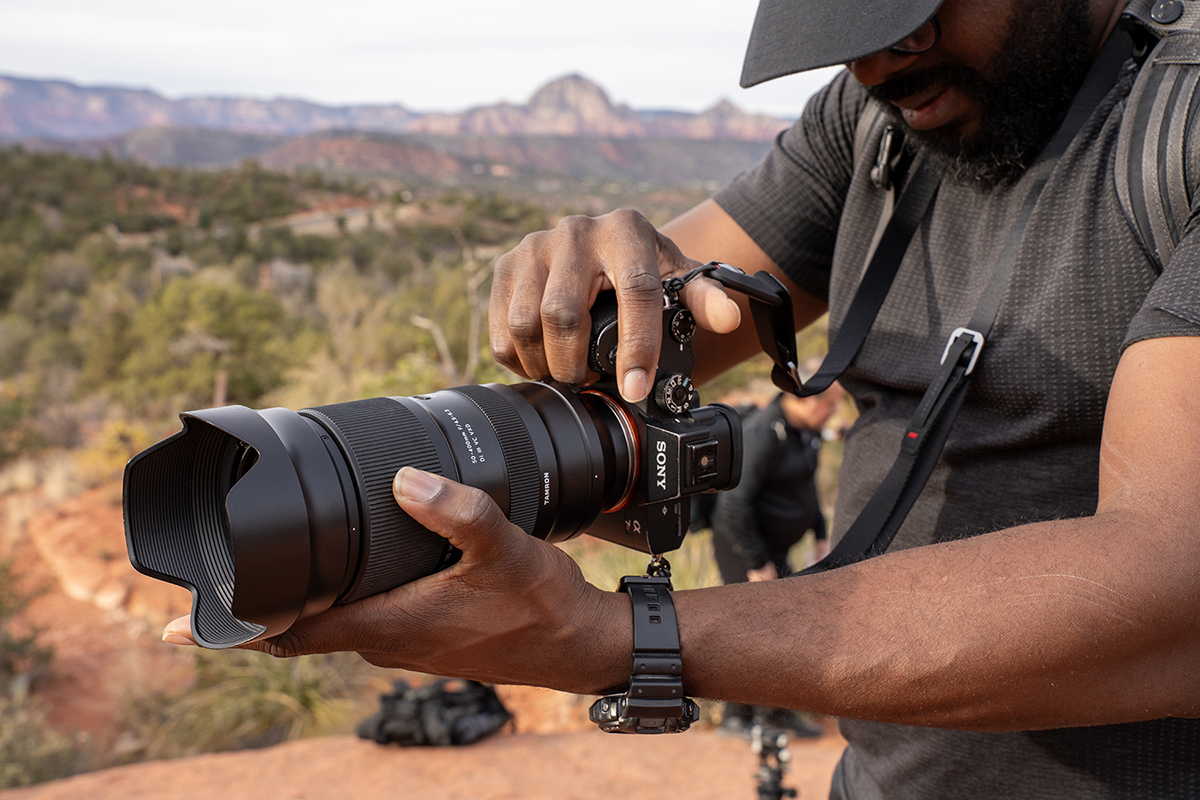Achieving Sharper Photos: A Guide to Camera Stability
If you’ve ever captured a photo that turned out blurry or filmed video footage that looked shaky, you’re not alone. Stability is essential for sharp images and smooth video, especially when shooting handheld, in low light, or with long focal lengths. That’s where understanding what image stabilization is becomes crucial. This guide breaks down how image stabilization works and why it’s a game-changer for both photographers and videographers.
In this article, you’ll learn:
- What image stabilization is and how it helps reduce camera shake
- The different types of stabilization: optical, in-body, and digital
- How Tamron’s VC (Vibration Compensation) technology enhances your photography
- When to use—or turn off—image stabilization
- Which Tamron lenses offer the best stabilization features for your needs

How Optical Image Stabilization Works and Why It Matters
Image stabilization (IS) helps reduce blur caused by camera movement. It’s essential for handheld photography and smooth video footage. IS compensates for vibration and shake from unsteady hands or unstable conditions. It’s also useful when using long lenses or ultra-telephoto zooms. This technology improves clarity through camera shake reduction.
Behind the Scenes: How Stabilization Systems Operate
Image stabilization works by detecting motion and shifting optical elements in the lens or camera to counteract it. Tamron’s unique VC (Vibration Compensation) mechanism is a proprietary technology that utilizes a combination of specialized actuators and advanced algorithms to ensure a stable viewfinder image with precise tracking capabilities. The mechanism uses a 3-coil system that leverages electromagnetic forces to drive specific lens elements, effectively counteracting any vibrations or movements that occur during shooting or filming. Tamron mounts the stabilizing lens element on three balls to ensure smooth movement with minimal friction. This design not only helps to achieve stability, but it also contributes to the compactness of Tamron lenses. Watch Tamron’s VC in action.

Different Approaches to Reducing Camera Shake
Type 1: Optical Image Stabilization (OIS)
This type of stabilization is built directly into the lens or camera lens system. It typically involves moving lens elements to compensate for detected motion. Optical Image Stabilization is particularly effective for still photography and works well with interchangeable lens cameras. Tamron’s OIS is called Vibration Compensation – VC and is a feature in many of Tamron’s newest zoom lenses for mirrorless cameras.
Type 2: In-Body Image Stabilization (IBIS)
Unlike OIS, which relies on stabilizing elements within the lens, IBIS systems are integrated into the camera body itself. IBIS works by shifting the camera’s image sensor to counteract movement. This type of stabilization is advantageous for cameras with fixed lenses or those that support various lenses without built-in stabilization. And the good news is that you can use both IBIS and OIS at the same time for greater stabilization results!
Type 3: Digital Image Stabilization (DIS)
Digital stabilization is implemented through software algorithms rather than physical mechanisms. It works by analyzing the captured image or video and digitally adjusting the frame to compensate for movement. While DIS can be effective to some extent, it’s generally considered less reliable compared to optical or in-body stabilization. That’s because DIS can degrade image quality by cropping or processing the image.
What Are the Benefits of Image Stabilization?

1. Improved Image Quality
Image stabilization significantly reduces camera shake, helping you capture sharper photos and smoother videos even in difficult situations such as low-light environments, long focal lengths, or handheld shooting at slow shutter speeds. This results in cleaner, more detailed images with fewer motion-induced blur artifacts.
2. Versatility in Shooting Conditions
With image stabilization built in, you can confidently shoot in a wider range of environments—whether you’re indoors, outdoors, or dealing with unpredictable lighting. It offers more flexibility when you don’t have a tripod handy, allowing you to adapt quickly and still achieve steady, professional-looking results.
3. Enhanced Creativity
Stabilization gives you the freedom to explore creative shooting techniques like panning, tracking moving subjects, or experimenting with longer exposures without the distraction of unwanted shake. This opens up more artistic possibilities and helps you execute your vision with precision.
4. User-Friendly Experience
For beginners or casual photographers, image stabilization provides a more forgiving and enjoyable shooting experience by increasing your chances of getting sharp, in-focus images. It reduces technical barriers so you can focus more on composition, timing, and creativity rather than worrying about maintaining perfect stability.
Top Tamron Lenses Equipped with VC (Vibration Compensation)
When capturing images in the ultra-telephoto range, even minor vibrations can result in a loss of image sharpness. And in low light, VC provides robust assistance for handheld photography in low-light conditions, such as evenings and indoor settings, eliminating the need for a tripod.
Find your standard, telephoto, or all-in-one camera lens with image stabilization from Tamron.
Standard Lenses
- Tamron 17-70mm F/2.8 Di III-A VC RXD (Model B070) for crop-sensor APS-C Sony E-mount and Fujifilm X-mount mirrorless cameras. The image stabilization in this fast standard zoom is optimized for both still and video use. When capturing video, the VC is leveraged by AI to automatically adjust to provide optimal compensation across various shooting scenarios. It’s wide to medium telephoto focal range is very versatile for interview work, portraits, and POV video.
- Tamron SP 24-70mm F/2.8 Di VC USD G2 (Model A032) for Canon and Nikon DSLR cameras offers fast, standard zoom performance with advanced VC (Vibration Compensation) image stabilization. Ideal for events, portraits, and travel, this lens helps deliver sharp, stable results in handheld and low-light situations. Its constant f/2.8 aperture and professional-grade optics make it a favorite for both stills and video shooters seeking versatility and clarity.
Telephoto Lenses
- Tamron 150-600mm F/5-6.3 Di VC USD G2 (Model A022) for Canon and Nikon DSLR cameras is a powerful ultra-telephoto zoom lens built for wildlife, sports, and aviation photography. Its extended reach and VC (Vibration Compensation) system enable sharp handheld shots, even at long focal lengths or in low light. The lens features a fast, precise USD (Ultrasonic Silent Drive) motor and a rugged build, making it an excellent choice for outdoor shooters who need stability and reach in one package.
- Tamron 150-500mm F/5-6.7 Di III VC VXD (Model A057) lens for Sony E, Fujifilm X and Nikon Z. This ultra-telephoto full-frame mirrorless camera lens comes with VC (Vibration Compensation) technology, ensuring clear images even in situations where camera movement is unavoidable, such as on a boat. The ultra-telephoto focal range is perfect for wildlife, sports, and birding where handholding may be frequent and where lighting is often low.
- Tamron 50-400mm F/4.5-6.3 Di III VC VXD (Model A067) for Sony E and Nikon Z mirrorless cameras. This lens has an 8X zoom range from standard focal length all the way to ultra-tele for great versatility. It is an ideal lens for outdoor sports where the action is constantly on the go moving comes close to the sidelines and moves across the field.
- Tamron 50-300mm F/4.5-6.3 Di III VC VXD (Model A069) for Sony E mirrorless cameras. The Tamron 50-300mm lens is a versatile zoom lens ideal for wildlife, sports, and landscape photographers who need a wide focal range to capture everything from distant subjects to broad scenes with clarity.
- Tamron 70-200mm F/2.8 Di VC USD G2 (Model A025) for Canon and Nikon DSLR cameras is a high-performance telephoto zoom lens designed for professional results. Its fast f/2.8 aperture and advanced VC (Vibration Compensation) system allow for sharp, handheld shooting even in low light. Ideal for sports, portraits, and events, this lens delivers fast, accurate autofocus and stunning image quality with smooth background separation.
- Tamron 70-180mm F/2.8 Di III VC VXD G2 (Model A065) for Sony E and Nikon Z. This fast telephoto zoom lens for mirrorless cameras is extremely compact and lightweight in its class and is ideal for handheld image-making with is VC image stabilization design.
All-In-One Lenses
- Tamron 18-300mm F/3.5-6.3 Di III-A VC VXD (Model B061) for crop-sensor APS-C Sony E-mount and Fujifilm X-mount mirrorless cameras. This all-in-one 16X zoom lens is perfect for travel that takes you indoors and out, from sunrise to sunset. The VC image stabilization allows you to handhold under all lighting conditions and achieve excellent image results.
- Tamron 28-300mm F/4-7.1 Di III VC VXD (Model A074) for Sony E mirrorless cameras. This highly versatile all-in-one zoom lens features VC (Vibration Compensation) image stabilization. This highly versatile all-in-one zoom lens features VC (Vibration Compensation) image stabilization. Travel and street photographers can capture everything from wide landscapes to distant subjects with sharpness and stability using this compact lens.
Limitations and Considerations of Image Stabilization

Image stabilization is extremely beneficial, but there are a few limitations you should take into consideration:
- If Your Subject is Moving: Image stabilization helps eliminate camera shake but it cannot compensate for motion caused by a moving subject. To capture sharp fast-moving subjects, you will need to use a higher shutter speed or other techniques to eliminate the motion blur.
- Turn Off Image Stabilization on a Tripod or Gimbal: When your camera lens is stabilized on a tripod or gimbal, leaving IS on can cause blur. When stabilization is already provided, leaving IS on may trigger unnecessary adjustments, causing the mechanism to move and blur images. Always turn off the image stabilization feature on your lens and/or in the camera body when using a tripod, gimbal or other stabilizing accessory.
- Battery Consumption: Continuous use of image stabilization can consume more battery power, particularly in cameras with in-body stabilization.
Conclusion
Image stabilization is a valuable tool for photographers and videographers, allowing you to capture sharper images and smoother footage in a variety of shooting conditions. Whether integrated into lenses or camera bodies, this technology enhances your shooting experience and expands your creative possibilities.
Learn about these lenses and more at an authorized Tamron dealer in your area or visit the TAMRON Store today.
More Photo Tips | Watch Videos | Learn More About Tamron Lenses | Photo Gallery
